What Are The Different Skin Types?
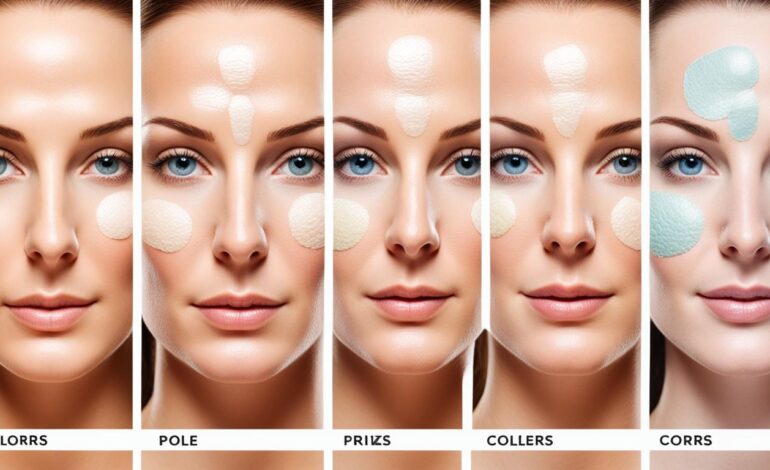
Skin is the body’s biggest organ, doing important jobs like keeping the body at the right temperature and fighting off germs. The outer layer of skin, called the skin barrier, is made mostly of lipids. It helps protect us. But, everyone’s skin is different, so there’s no single way to get healthy, glowing skin. There are five main skin types: normal, dry, oily, combination, and sensitive. Each type has its own needs for care.
Key Takeaways
- Skin is the body’s largest organ with important functions like temperature regulation and protection.
- The skin barrier is composed of lipids and acts as a protective layer.
- There are five main skin types: normal, dry, oily, combination, and sensitive.
- Each skin type has unique characteristics and requires tailored care.
- Understanding your skin type is crucial for developing an effective skincare routine.
Introduction to Skin Types
Knowing your skin type is key to having healthy, glowing skin. Your skin type comes from your genes, but things outside and inside can change it. Figuring out your skin type helps you pick the right products and routines for your skin.
Also Read : How Can Diet Affect Sensitive Skin?
Understanding the Importance of Skin Types
Knowing your skin type is the base of good skincare. Each type needs special care because of its unique traits. By knowing what your skin type is like, you can choose the best products and practices for you.
Also Read : What Are The Benefits Of Skin Care Advertisements?
- Skin types range from normal to dry, oily, combination, and sensitive.
- Each skin type has its own set of characteristics, such as pore size, oil production, and susceptibility to dryness or breakouts.
- Choosing the right skincare products for your skin type can help you achieve a healthy, glowing complexion and address any skin concerns you may have.
Understanding your skin type is the first step in making a good skincare routine. By knowing what makes your skin unique, you can focus on what it needs. This helps you take care of your skin better and solve any problems you have.
Also Read : What Causes Facial Redness And How Can It Be Treated?
“Knowing your skin type is the key to unlocking the secret to healthy, radiant skin.”
| Skin Type | Characteristics | Skincare Needs |
|---|---|---|
| Normal | Balanced oil production, no visible pores, even skin tone | Gentle cleansers, moisturizers, and sun protection |
| Dry | Tight, flaky, or rough texture, visible fine lines | Hydrating cleansers, rich moisturizers, and serums |
| Oily | Shiny, large pores, prone to breakouts | Oil-free cleansers, mattifying products, and oil-absorbing ingredients |
| Combination | Oily in the T-zone, dry on the cheeks and around the eyes | Targeted products for different areas, balancing moisturizers |
| Sensitive | Easily irritated, redness, and/or stinging upon product application | Gentle, fragrance-free cleansers and moisturizers |
Normal Skin
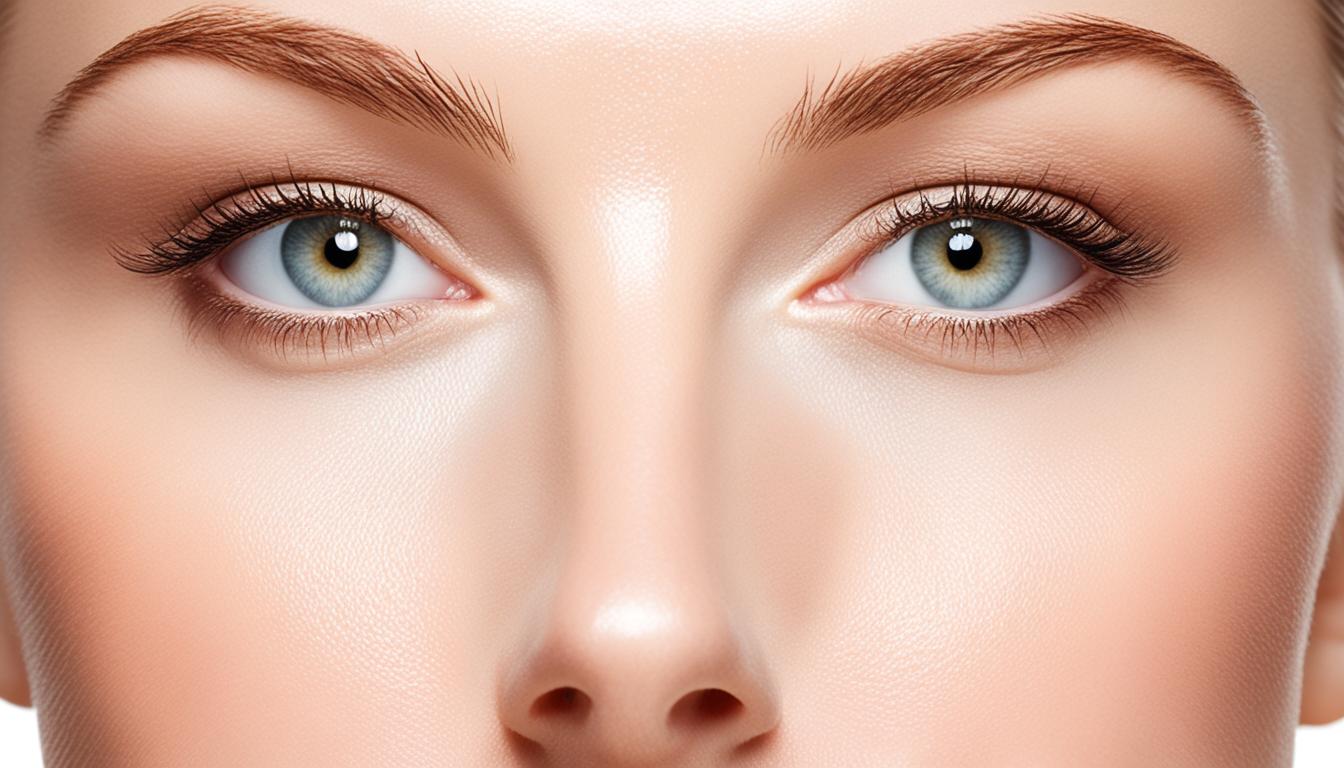
If your normal skin is well-balanced, neither too oily nor too dry, you’re one of the lucky ones. Normal skin has a velvety, soft, and smooth texture. It also has good blood circulation and a fresh, rosy complexion.
Also Read : Can Sun Spots Be Prevented With Proper Skincare?
It’s not prone to sensitivity or blemishes and has small, barely visible pores. As people age, normal skin can become drier. But it remains the ideal skin type.
Also Read : What Are Effective Home Remedies For Fine Lines?
Those with normal skin don’t have to worry too much about their skin concerns. Yet, it’s still key to keep the skin healthy and nourished. A gentle, balanced skincare routine is crucial to keep the skin’s natural balance and glow.
Even if your skin is naturally normal, it can still behave differently. This can be due to environmental factors or lifestyle choices. It’s important to pay attention to how your skin tends to react. Then, make adjustments as needed to keep the skin in top condition.
While normal skin may seem like a low-maintenance skin type, it still needs proper care. By following a consistent, gentle skincare routine, you can help keep the skin looking its best.
“The key to maintaining normal skin is to listen to what your skin is telling you and make adjustments as needed.”
Dry Skin

Dry skin is a common issue many people face. It lacks moisture and lipids, making the skin barrier weak. Knowing what causes and what it looks like is key to keeping skin healthy and moisturized.
Causes and Characteristics of Dry Skin
Many things can cause dry skin, like your genes, age, and the environment. As we get older, our skin makes less sebum, which is important for moisture. Harsh weather, washing your hands a lot, and some skincare products can also dry out the skin.
People with dry skin might feel their skin is tight, flaky, and see more fine lines and wrinkles. It can feel rough and look dull. In bad cases, it can crack and get really sensitive.
| Characteristic | Description |
|---|---|
| Tightness | The skin feels tight, especially after cleansing or exposure to dry environments. |
| Flakiness | The skin appears rough and scaly, with visible flakes or patches of dry, dead skin cells. |
| Dullness | The skin looks lackluster and lacks a healthy, radiant glow. |
| Increased Visibility of Fine Lines and Wrinkles | The skin’s lack of moisture can emphasize the appearance of fine lines and wrinkles. |
| Sensitivity | Dry skin is more prone to irritation, redness, and discomfort, especially on the hands, feet, elbows, and knees. |
Understanding dry skin helps people take steps to fix it. This way, they can balance their skin’s moisture and hydration.
Oily Skin
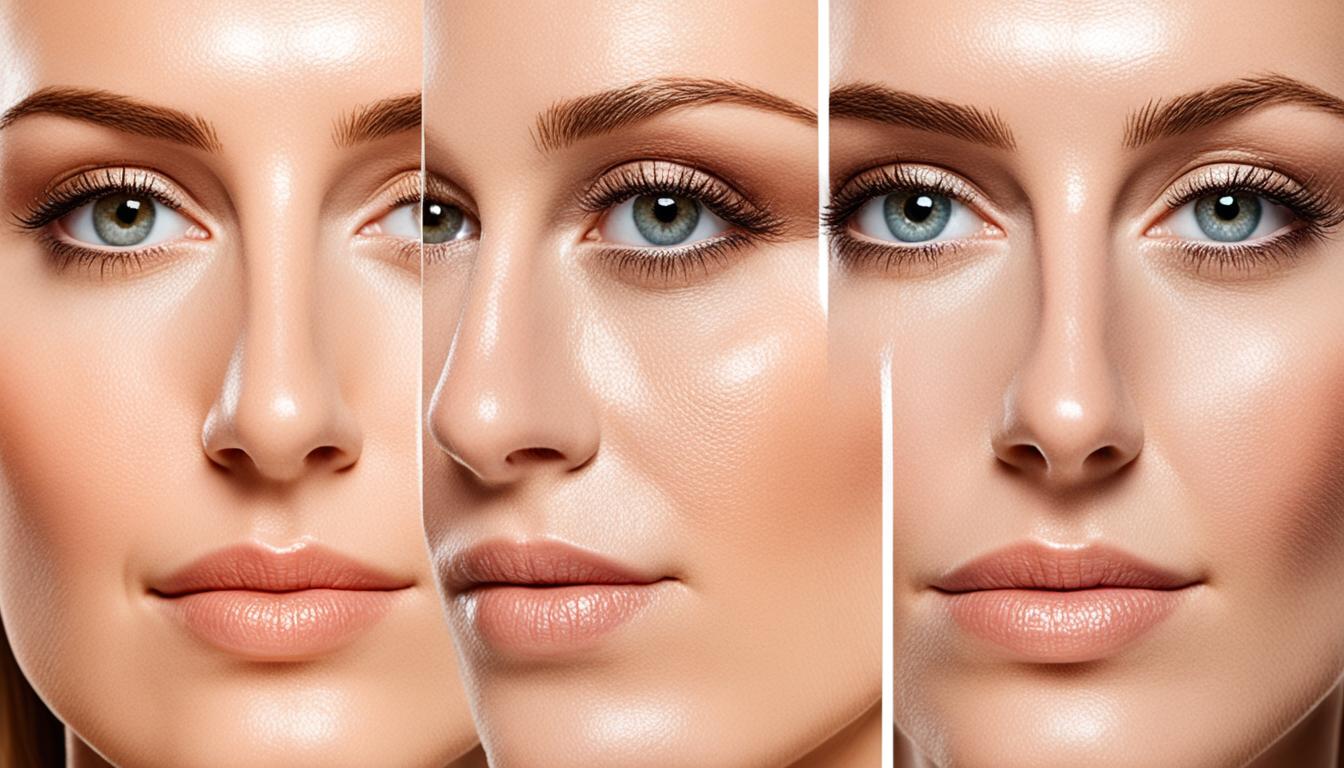
If your skin looks shiny, greasy, or feels heavy all day, you might have oily skin. People with oily skin often deal with big pores, lots of breakouts, and a shiny look. This happens because of genetic factors, hormonal imbalances, stress, and environmental conditions like heat and humidity.
Oily skin means your skin makes too much sebum, the oil that keeps skin moisturized. Too much oil can cause problems like:
- Enlarged pores that are more prone to clogging and blackheads
- Increased risk of acne and blemishes
- A shiny, greasy appearance that can be hard to control all day
- Difficulty making makeup last and look smooth
Knowing your skin type is key to finding the right skincare routine. For oily skin, use products that are oil-free and won’t clog pores. Choose gentle cleansers, matte moisturizers, and blotting papers to help control shine and keep oily skin looking good.
| Characteristics of Oily Skin | Potential Challenges |
|---|---|
| Shiny, greasy appearance | Frequent breakouts and blemishes |
| Enlarged, visible pores | Difficulty keeping makeup in place |
| Thick, heavy texture | Increased risk of blackheads and whiteheads |
Combination Skin
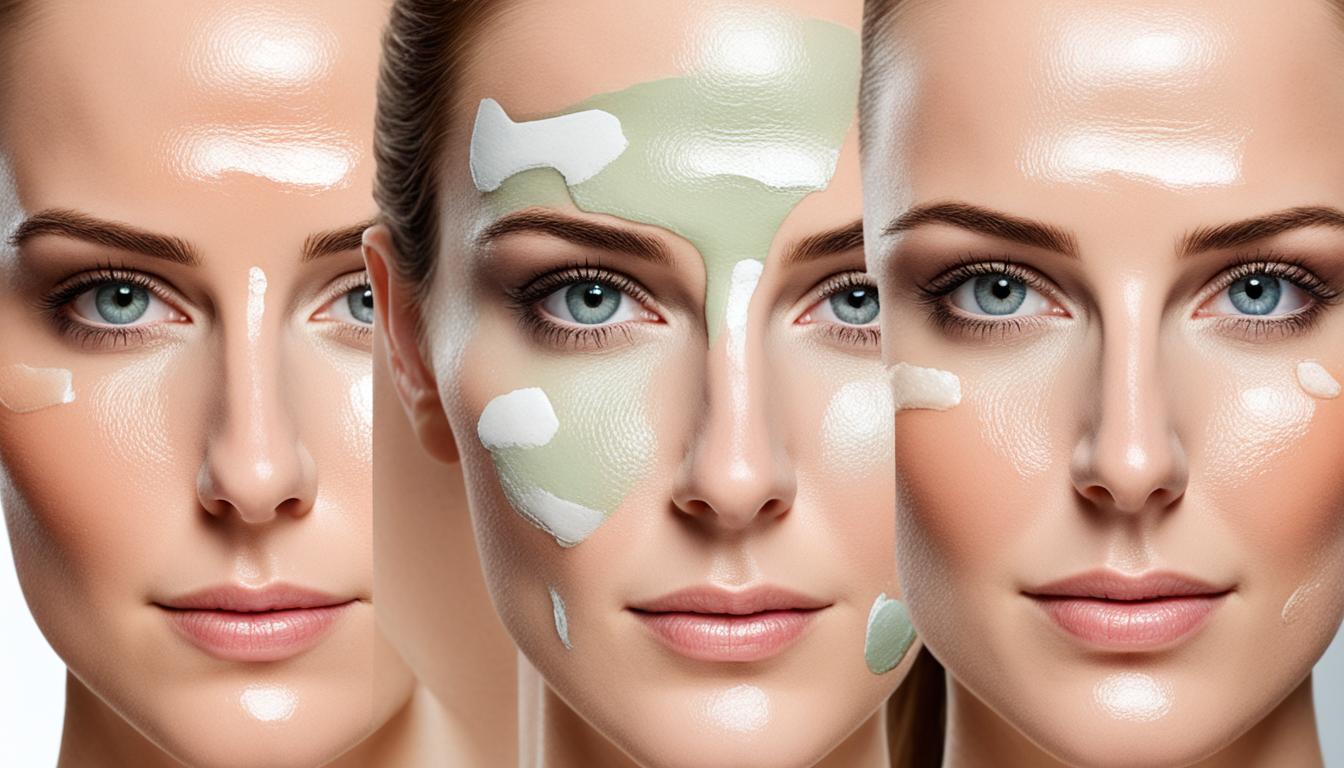
Combination skin is special because it has different areas. It often has an oily T-zone (forehead, nose, and chin) and dry cheeks. This mix can lead to big pores, shine, and spots in the T-zone. The cheeks might feel dry or flaky.
Identifying and Caring for Combination Skin
Looking after combination skin means finding the right balance. You should not dry it out or make it too oily. Here are some tips for managing combination skin:
- Use a mattifying, oil-controlling product in the T-zone to manage shine and blemishes.
- Apply a hydrating, nourishing formula to the cheeks to keep them supple and healthy.
- Exfoliate regularly to remove dead skin cells and unclog pores, but be gentle to avoid irritation.
- Opt for a lightweight, non-comedogenic moisturizer that won’t clog pores.
- Blot excess oil throughout the day to maintain a balanced, healthy-looking complexion.
Understanding your combination skin and adjusting your skincare routine can help. You can get a glowing, balanced skin type that looks and feels great.
“The key to managing combination skin is to address the needs of each zone individually, rather than a one-size-fits-all approach.”
Sensitive Skin

Sensitive skin needs special care because it reacts easily to things. It can turn red, feel itchy, and get dry. This happens with any skin type and is often caused by certain products or the environment.
Those with sensitive skin should be careful with new products. Using gentle, fragrance-free products helps keep their skin healthy. It’s important to avoid things that might irritate their skin.
Sensitive skin doesn’t make much sebum, which is the oil that keeps skin moisturized. So, it can feel dry and be more affected by the environment. Even oily skin can be sensitive and react badly to some products.
If you think you have sensitive skin, pay attention to how your skin reacts. Knowing your skin type helps you pick the right products and routines. Sensitive skin needs gentle, caring products to stay healthy and look good.
“Treating sensitive skin requires a delicate approach, as harsh products or ingredients can further aggravate and disrupt the skin’s natural balance.”
skin types
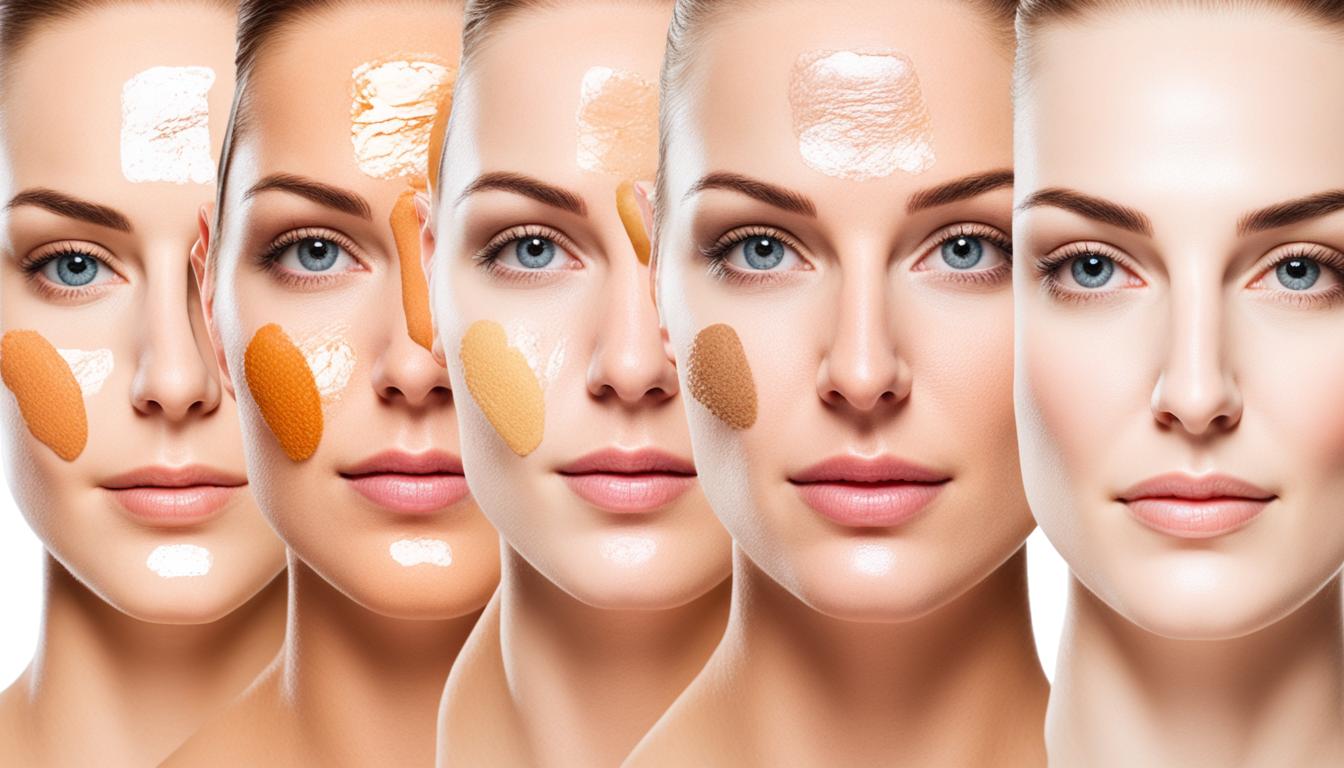
There is no single solution for all skin types. Humans have five main skin types: normal, dry, oily, combination, and sensitive. Each type has its own traits. Knowing these differences helps in creating a good skincare routine.
Normal skin is often seen as the best skin type. It’s not too oily or dry. It has the right amount of sebum, making it look healthy and glowing. People with normal skin usually have small pores and smooth skin on their face, including the cheeks and T-zone.
Dry skin lacks natural oils, making it tight and flaky. It can be itchy or red and more likely to have fine lines and wrinkles. On the other hand, oily skin produces too much sebum. This makes the skin look shiny and can lead to more acne.
Combination skin is a mix of oily and dry skin. The T-zone (forehead, nose, and chin) is oily, while the cheeks are dry. This skin type needs a special approach to balance its different areas.
Sensitive skin reacts more to the environment and some skincare products. It can get red, irritated, and break out easily. People with sensitive skin need to be careful with what they use on their skin.
Knowing your skin type is key to a good skincare routine. By understanding your skin, you can pick the right products and methods for healthy, glowing skin.
At-Home Skin Type Tests
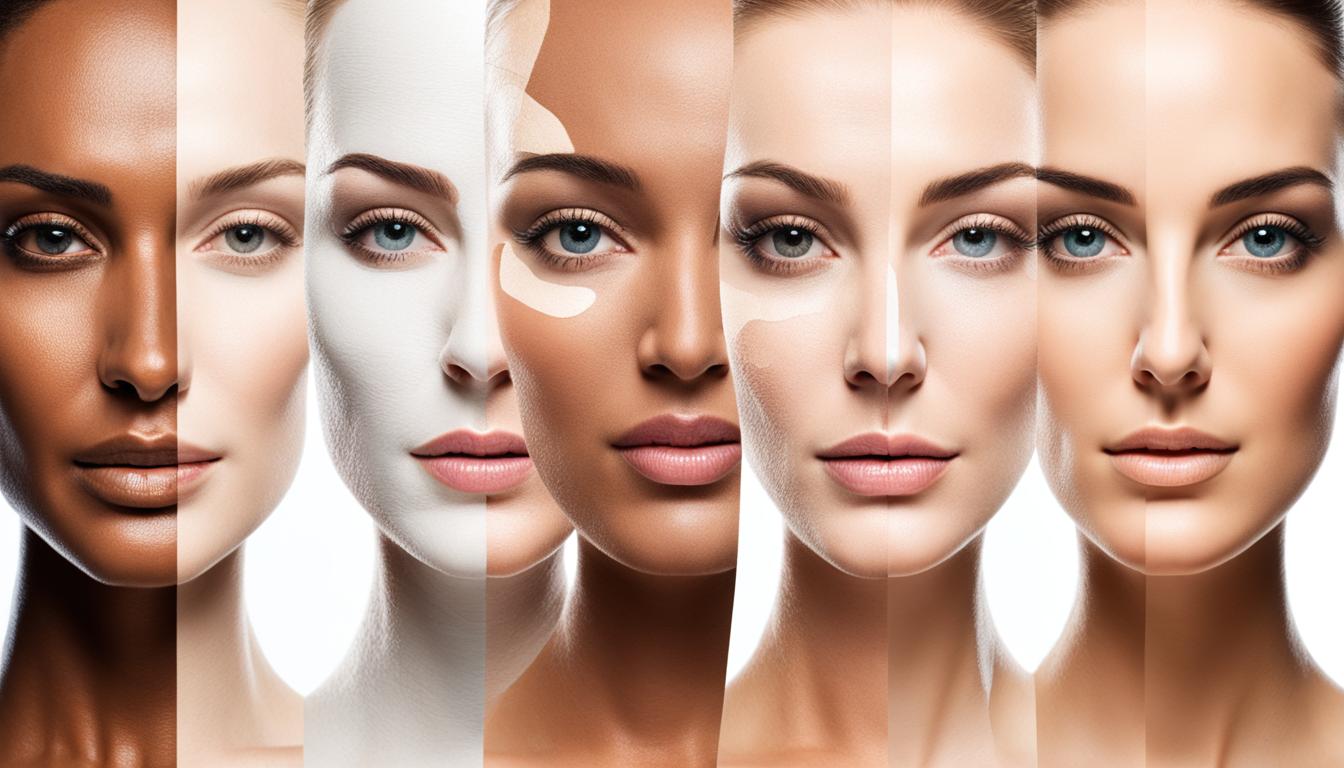
Finding out your skin type is key to a good skincare routine. If you’re not sure about your skin type, try these simple tests at home. They can help you figure out your skin type and match your skincare products better.
The “Watch and Wait” Method
The “watch and wait” method is easy to follow. First, clean your face to get rid of any oil or product. Then, wait for 30 minutes and see how your skin looks.
If your skin looks shiny or oily, you probably have oily skin. If it feels dry and flaky, you might have dry skin. If you see both oily and dry spots, you could have combination skin. If your skin looks balanced and feels good, you likely have normal skin.
The Blotting Sheet Method
The blotting sheet method is another good way to test your skin type. Start by pressing a blotting sheet on your face, like on the forehead, nose, cheeks, and chin. See how much oil the sheet absorbs.
If the sheet takes up a lot of oil, especially in the T-zone, you might have oily skin. If it doesn’t absorb much oil, you could have dry skin. A bit of oil absorption in different spots means you might have combination skin.
Both the “watch and wait” and blotting sheet methods can help you determine your skin type. Knowing your skin type helps you pick the right products and meet your skin’s needs.
Factors Influencing Skin Condition
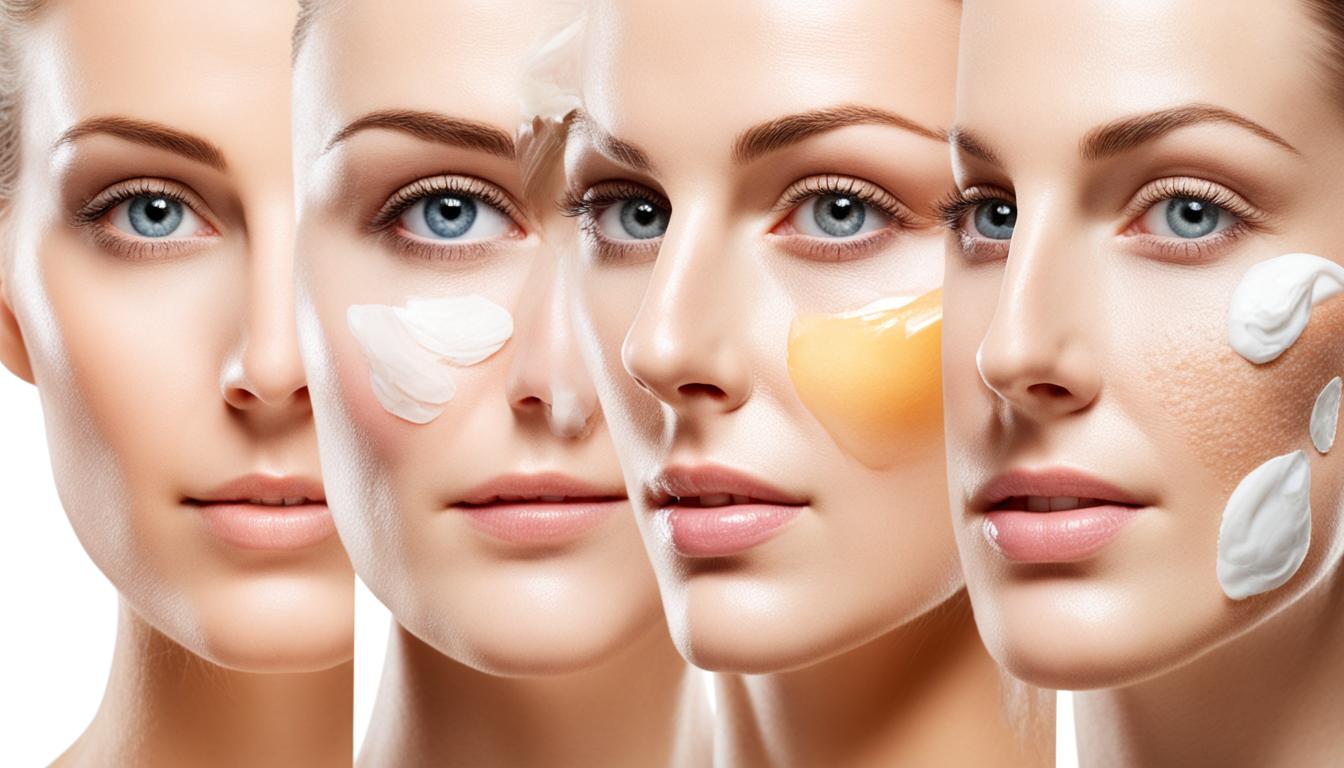
Your skin’s condition comes from both inside and outside. Things like your environment and lifestyle play a big role. Knowing how these affect your skin helps you choose better skin care routines and habits for a healthy look.
Environmental Factors
Things like the weather, pollution, and UV exposure affect your skin. Dry, mature skin might get more dry and flaky in windy, dry places. Oily skin might get even oilier in hot, humid weather. Knowing what your skin reacts to can help you protect and moisturize it better.
Lifestyle Factors
What you do every day also impacts your skin on your cheeks and face. Things like what you eat, how stressed you are, how well you sleep, and the skin care products you use matter. These can change how your skin makes oil, holds moisture, and reacts to the environment. Making smart choices can lead to healthier, glowing skin.
Noticing how your skin feels and reacts to things can help you figure out your skin type. This can lead to a skin care routine that works for you, no matter the weather or lifestyle.
Professional Skin Analysis
If you’re unsure about your skin type or have concerns, see a dermatologist or skincare expert. They can give you a personalized skin analysis. They use special tools and methods to check your skin condition. They can spot issues and suggest the best skincare routine for you.
A skin analysis by a pro looks at your skin closely. They check its texture, how it feels, how much oil it makes, and its health. To figure out your skin type, they might use:
- Visual assessment: They look at your skin to see if it’s dry, oily, or sensitive.
- Diagnostic tools: They use special devices to check skin moisture, oil, and more.
- Skin sampling: They take a small skin sample for lab tests.
After checking, the dermatologist will give you advice to keep your skin healthy. This might mean changing your skin care routine, trying new treatments, or changing your lifestyle to maintain healthy skin.
| Skin Analysis Method | Benefits |
|---|---|
| Visual Assessment | Looks at your skin closely to check its look, feel, and health. |
| Diagnostic Tools | Uses special devices to measure important skin health things like moisture and oil. |
| Skin Sampling | Allows for detailed lab tests to find any skin conditions or problems. |
By getting help from a dermatologist, you’ll learn about your skin type and the best skin care routine for it. This way, you can have healthy, glowing skin.
Also Read : Affordable Skin Care Products For All Skin Types And Budgets
Conclusion
Understanding your skin type is key to a healthy, glowing look. Whether your skin is normal, dry, oily, combination, or sensitive, knowing its needs helps you pick the right skincare products. This lets you create a routine that works for you.
It’s important to pay attention to your skin’s changes and get advice when needed. This way, you can adjust your skincare to keep up with your skin’s needs.
Accepting the variety in skin types is crucial for good skin health. Choosing the right moisturizers and cleansers is easier when you know your skin type. This helps you make your skincare journey more effective.
By staying aware of your skin’s changing needs, you can keep it looking great. This ensures your skin stays vibrant, radiant, and strong over time.
Beautiful, healthy skin comes from knowing and meeting your skin’s unique needs. By understanding your skin type and tailoring your skincare, you can achieve a look and feel that’s amazing.
FAQs
Q: What are the different skin types?
A: There are mainly four different skin types: oily, dry, normal, and combination. Knowing your skin type is crucial in choosing the right skincare products.
Q: How can I determine my skin type?
A: You can determine your skin type by observing how your skin behaves during the day. Factors like oiliness, dryness, and sensitivity can help identify your skin type.
Q: What is the best moisturizer for oily skin types?
A: For oily skin types, it’s best to look for oil-free and non-comedogenic moisturizers that won’t clog pores. Water-based or gel moisturizers are also good choices.
Q: What skincare routine should I follow for combination skin?
A: A skincare routine for combination skin should involve using products that cater to both oily and dry areas of the face. This can include using a gentle cleanser, balancing toner, and a lightweight moisturizer.
Q: How can I care for my sensitive skin?
A: People with sensitive skin should opt for gentle, fragrance-free products and avoid harsh chemicals. Patch testing new products before full use is also recommended.
Q: What are the characteristics of each skin type?
A: Oily skin tends to produce excess sebum, dry skin lacks oil and feels tight, normal skin is well-balanced, and combination skin has a mix of oily and dry areas on the face.
Q: Why is it essential to know your skin type?
A: Knowing your skin type helps in choosing the right products that will address your specific skin concerns, leading to a more effective skincare routine.
